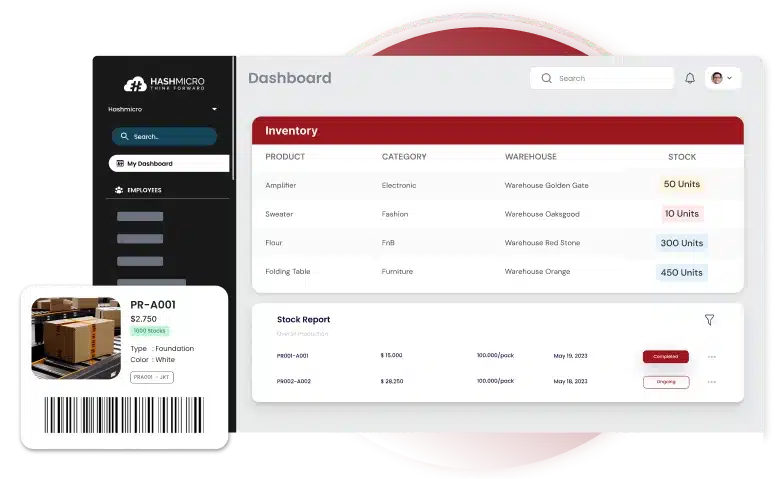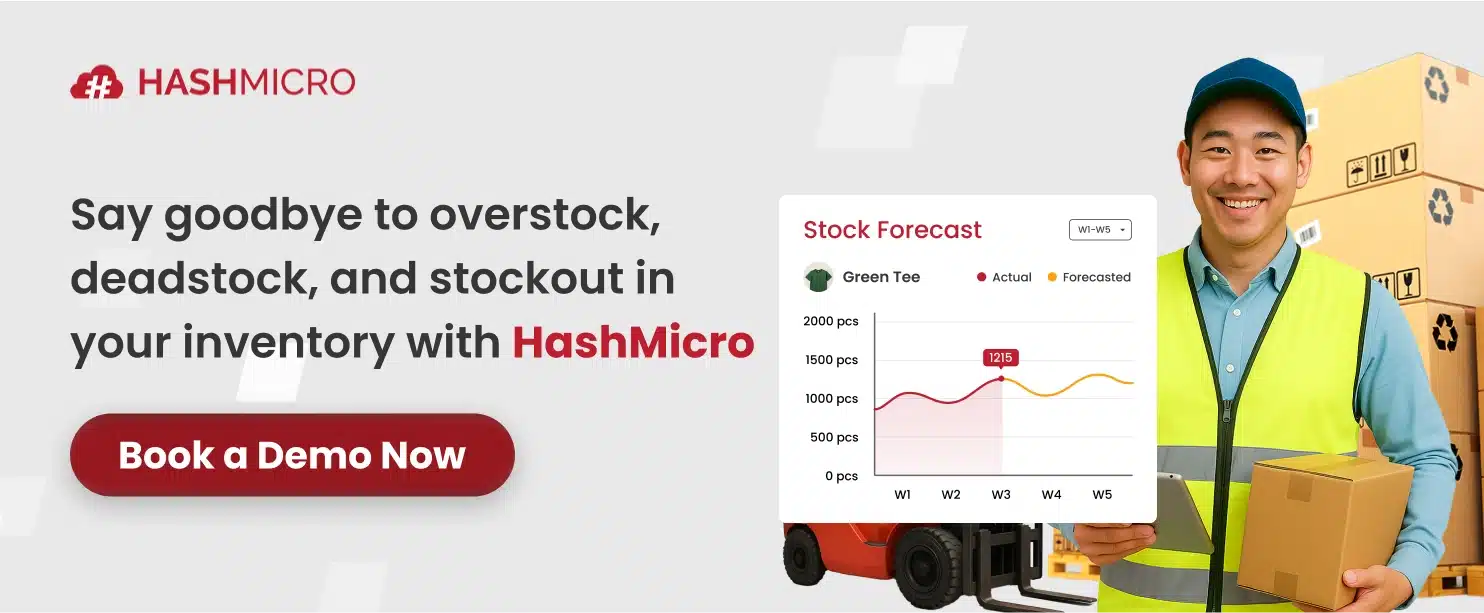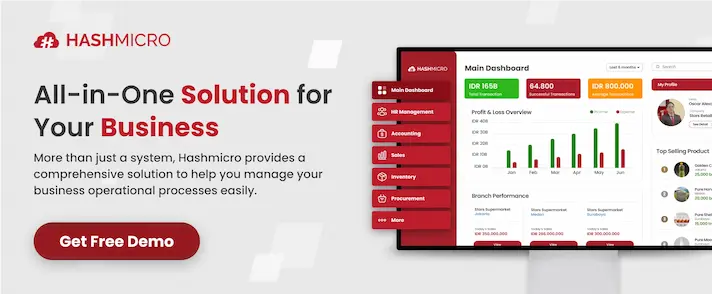I use a periodic inventory system to update stock levels at specific intervals, allowing me to track inventory and calculate the cost of goods sold efficiently. This method helps me maintain accurate financial performance without needing continuous updates.
Managing inventory can be challenging due to stock discrepancies, inaccurate data, and time-consuming manual processes. With the periodic inventory system, I can simplify tracking and reporting, ensuring better control over stock movements.
In this article, I’ll share the key benefits, challenges, and best practices for implementing a periodic inventory system effectively. If you’re ready to optimize your inventory management, try HashMicro’s free demo today and see how automation can transform your operations.
Key Takeaways
|
What is a Periodic Inventory System?
A periodic inventory system is an accounting method where inventory counts and costs of goods sold (COGS) are calculated at the end of an accounting period. Instead of tracking inventory continuously, this system relies on periodic intervals, such as monthly, quarterly, or annually, to assess the stock levels.
It provides a snapshot of inventory and COGS for that specific period, helping businesses determine their financial standing at the time of the count. Under this system, businesses don’t need to maintain real-time inventory records.
Instead, they record purchases in bulk as they occur, and only adjust their records during the periodic inventory count. This is beneficial for companies with large inventories or those that experience less frequent stock turnover, as it reduces the need for constant updates throughout the period.
How Periodic Inventory System Works?
In a periodic inventory system, businesses track inventory purchases and sales in bulk at specific intervals. The system doesn’t continuously update records with each sale or purchase; instead, it relies on physical counts at the end of the period to determine the current stock level.
The company will tally the remaining inventory, then use this figure to calculate the cost of goods sold (COGS) and update their financial statements accordingly. At the end of the period, the physical count allows for the necessary adjustments to the inventory records.
This method is often less resource-intensive compared to perpetual systems, as it doesn’t require real-time tracking. However, businesses using a periodic inventory system must ensure that the count is accurate to avoid discrepancies and maintain reliable financial reporting.
Periodic Inventory vs. Perpetual Inventory

When choosing an inventory system, understanding the differences between periodic and perpetual methods is essential. Each offers unique benefits and challenges that can affect business operations. Let’s explore how these two systems compare.
1. Inventory tracking
A periodic inventory system updates stock and COGS at the period end via a physical count, which leads to delayed data in the general ledger. A perpetual inventory system continuously tracks every transaction, offering real-time updates.
2. Cost and resource requirements
The periodic method relies on essential tools and physical counts of raw material, though it can be labor-intensive. The perpetual inventory method, while more expensive, uses advanced tech like barcode scanners, providing automation to the general ledger.
3. Accuracy and data reliability
The periodic inventory system’s accuracy depends on physical counts, which can create discrepancies in the general ledger. On the other hand, a perpetual inventory system ensures higher accuracy by instantly updating inventory levels with each transaction.
4. Financial reporting
The periodic inventory method restricts financial updates to period-end, delaying income statement reports and requiring general ledger adjustments. In contrast, the perpetual inventory method enables continuous reporting, providing real-time insights into inventory levels.
5. Suitability for different business models
A periodic inventory system is ideal for businesses with stable, low-volume turnover. It offers a cost-effective option without real-time inventory level tracking. On the other hand, a perpetual inventory system is ideal for high-volume operations.
When Would You Use A Periodic Inventory System?
When your business has stable, low-volume inventory turnover or real-time tracking isn’t crucial, you would use a periodic inventory system. This method is ideal for operations where inventory levels, such as retail or wholesale businesses, don’t fluctuate significantly.
Additionally, a periodic inventory method is suitable when minimizing costs and simplifying inventory management are priorities. Implementing a cloud based inventory system can enhance this approach by providing better accessibility and integration with other business processes, and generate reports when needed. It’s beneficial for businesses that can rely on periodic physical counts to update records without needing constant updates to the general ledger.
Integrating logistics management software can enhance the periodic inventory method for businesses seeking to optimize inventory management. It improves control over inventory movements, bridging the gap between periodic checks and real-time tracking.
Benefits of Periodic Inventory System

The periodic inventory system offers numerous advantages that can enhance business operations. This system simplifies inventory management and improves efficiency by focusing on periodic updates and physical counts. Here are some of the key benefits:
1. Cost reduction
A periodic inventory system allows businesses to save costs by avoiding the need for constant updates. The reliance on physical counts streamlines the process, keeping the general ledger simpler and more manageable, especially for operations with stable inventory levels.
2. Simplified inventory tracking
This inventory system simplifies inventory tracking by requiring updates only at specific intervals. This reduces the need for continuous monitoring of the general ledger, allowing businesses to focus on operations while maintaining accurate inventory level assessments.
3. Increased accuracy and efficiency
A periodic inventory system improves accuracy and efficiency by updating the general ledger after regular physical counts. It ensures precise inventory levels and streamlines accounting processes, resulting in more accurate financial reports and better resource management.
4. Easier inventory audits
This system facilitates easier inventory audits by concentrating inventory assessments at specific intervals. Regular physical counts help ensure that inventory levels match the records in the general ledger, making the audit process less time-consuming.
5. Enhanced customer satisfaction
By utilizing a periodic inventory system, businesses can ensure that inventory levels are accurately reflected in the general ledger after each physical count. This accuracy helps fulfil customer orders more efficiently, leading to higher satisfaction and repeat business.
Challenges of Periodic Inventory
While a periodic inventory system offers certain advantages, it also comes with several challenges that businesses must consider. Understanding these challenges is crucial for determining the method that aligns with your needs. Here are some of the key challenges:
- Lack of real-time data
- Increased risk of discrepancies
- Labor-intensive process
- Delayed financial reporting
- Limited inventory control
To address these challenges, advanced inventory management software offer real-time tracking and automation, overcoming the limitations of periodic methods. These systems enhance accuracy, reduce manual errors, and streamline processes.
If you’re seeking inventory management software recommendations, we’ve curated a list of top solutions to fit diverse needs. These options address challenges and optimize inventory control, helping you find the right system for your business.
HashMicro as an All-in-One Inventory Management System

HashMicro Inventory Management Software is a comprehensive ERP solution for streamlining inventory processes. The system provides real-time tracking, automated stock management, and seamless integration with other business functions for efficient operations.
HashMicro provides a free demo and consultation for its ERP software, giving businesses a hands-on look at its features. This allows potential users to see how the system fits their needs and ensures they make an informed decision about integrating it into their operations.
Moreover, HashMicro is trusted by leading companies across diverse industries, including McDonald’s, Hino, and Forbes, for its robust ERP solutions. This wide adoption highlights its reliability and effectiveness in addressing complex inventory and business management needs.
Features:
- Stock take and inventory adjustment management
This feature facilitates periodic physical counts and updates inventory records, thus ensuring accurate stock levels. It helps businesses maintain precise inventory data by managing adjustments made during physical stock takes.
- Stock aging report
The stock aging report provides insights into the age of inventory items, helping businesses manage stock turnover effectively. Highlighting older stock aids in reducing holding costs and optimizing inventory levels during periodic reviews.
- Fast moving slow, moving stocks analysis
This analysis identifies fast and slow-moving inventory items, allowing businesses to adjust stock levels accordingly. It helps optimize inventory management by ensuring that high-turnover items are adequately stocked and slow-moving items are managed efficiently.
- Stock optimizer
This feature manages inventory levels across multiple warehouses, helping to balance stock and reduce excess inventory. Consequently, this feature ensures that each warehouse operates efficiently, supporting accurate stock management during periodic evaluations.
- Stock reservations & reporting
This feature allows for managing stock reservations and generating detailed reports. Documenting reserved stock supports accurate inventory tracking and planning and aids in precise periodic reviews and adjustments.
- Integrated with barcode & QR code
Barcode and QR code integration streamline inventory tracking and management. This feature enhances accuracy during physical counts, making the periodic inventory process more efficient and reducing manual errors.
- Lot & serial number management
Lot and serial number management tracks inventory with unique identifiers, providing precise records for periodic counts. Therefore, it offers detailed traceability and accuracy, which is crucial for effective inventory management and reporting.
“An efficient periodic inventory system helps businesses maintain financial accuracy without heavy automation. It’s ideal for smaller operations seeking simplicity, cost control, and clear insight into stock performance at set intervals.”
— Angela Tan, Regional Manager
Conclusion
Businesses often encounter issues with inventory management, such as inaccuracies and inefficiencies in tracking stock levels. A periodic inventory system helps by providing regular updates through physical counts, ensuring accurate records and smoother operations.
HashMicro Inventory Management Software offers a robust ERP solution for optimizing inventory management and enhancing efficiency. It provides real-time tracking, advanced analytics, and seamless integration, making it a valuable tool for better operational control.
Take the first step toward efficiency and experience HashMicro’s benefits firsthand. Sign up for a free demo today to explore how our software can improve inventory management.
Warning: Undefined array key "med" in /home/hashmicr/public_html/blog/wp-content/plugins/insert-headers-and-footers/includes/class-wpcode-snippet-execute.php(419) : eval()'d code on line 281

Frequently Asked Questions About Periodic Inventory System
-
What are the three methods of periodic inventory?
Three methods of periodic inventory are:
1. FIFO (First In, First Out)
Under FIFO, the oldest inventory items are considered sold first. In a periodic inventory system, this method calculates COGS and ending inventory based on the assumption that the earliest purchases are the first to be sold, which affects financial reporting and tax calculations.
2. LIFO (Last In, First Out)
With LIFO, the most recent inventory items are sold first. This method calculates COGS and ending inventory, assuming the latest purchases are the first to be sold. It can impact financial results differently from FIFO, especially during rising prices.
3. Weighted Average Cost
This method calculates COGS and ending inventory based on the average cost of all inventory items available for sale during the period. The average cost is computed by dividing the total cost of goods for sale by the total number of units available. -
What is COGS in the periodic inventory system?
In a periodic inventory system, the Cost of Goods Sold (COGS) is calculated at the end of the accounting period based on the inventory counts and purchases made. This method involves determining COGS after performing a physical count of the ending inventory, reflecting the direct costs associated with goods sold during the period.
-
What companies use periodic inventory systems?
Periodic inventory systems are often used by small retailers, wholesalers with stable inventory levels, and businesses with limited resources. Small retailers and wholesalers benefit from the simplicity and lower costs of periodic inventory management.
Businesses with fewer resources may opt for periodic systems to avoid the costs associated with real-time tracking. Additionally, manufacturing firms with predictable production cycles might choose this method when continuous inventory tracking isn’t crucial for their operations.































